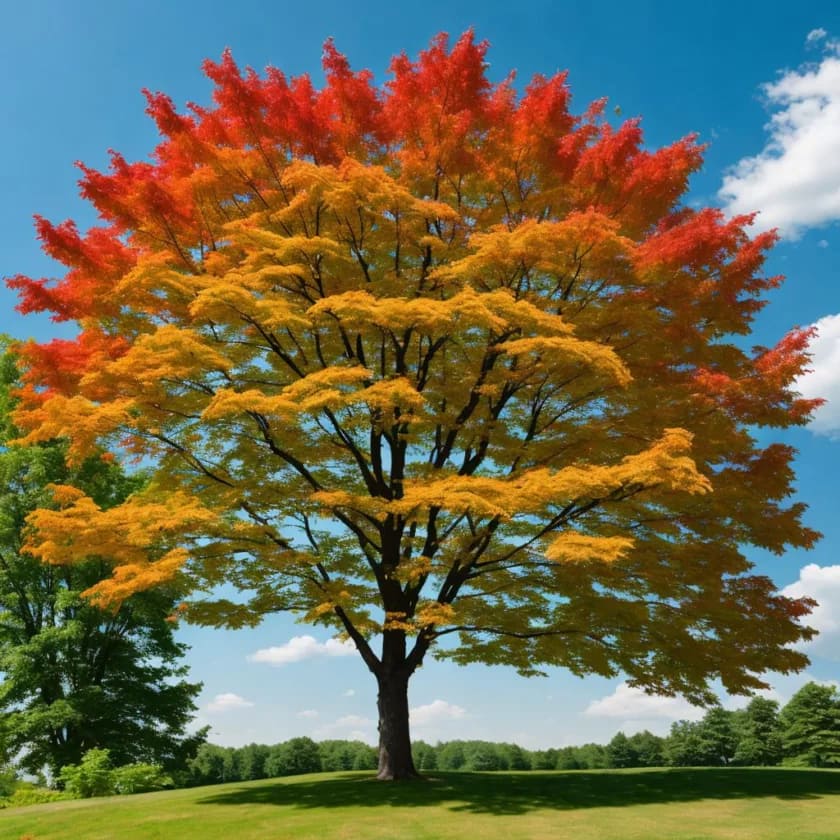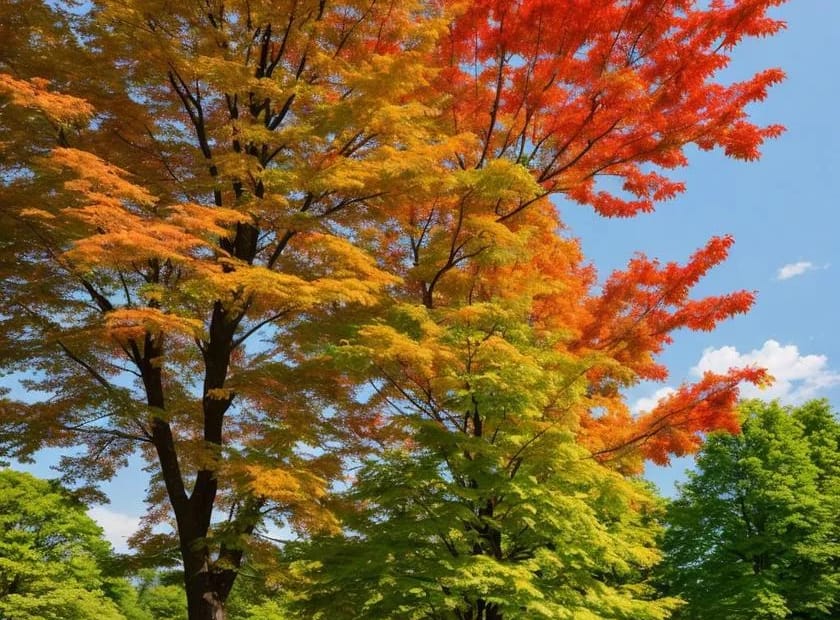Maple Tree – Acer spp
Among Native American tribes, the maple tree is revered for its sweet sap, which symbolizes the lifeblood of the Earth. It’s often associated with the changing seasons and the cycle of life.
The maple tree (Acer spp.) holds significant cultural and symbolic importance among Native American tribes. Its sap, which can be processed into maple syrup, is particularly revered for its sweetness and is often seen as a symbol of the lifeblood of the Earth. The symbolism and significance of the maple tree vary among different tribes, but there are some common themes associated with it:
- Seasonal Symbolism: Maple trees are known for their distinctive leaf changes during the fall, when their leaves turn vibrant shades of red, orange, and yellow. This seasonal transformation is often seen as a representation of the changing seasons and the cyclical nature of life. It serves as a reminder of the interconnectedness of all living things and the constant renewal of life.
- Harvest and Nourishment: The sap collected from maple trees has been a valuable source of food and sustenance for Native American tribes for generations. It is rich in essential nutrients and provides a source of nourishment during the late winter and early spring when other food sources may be scarce. The act of tapping maple trees and collecting sap is a cultural tradition that symbolizes the reliance on the land for sustenance.
- Spiritual Significance: Some tribes have specific spiritual beliefs and ceremonies related to maple trees. The sap may be viewed as a gift from the Creator, and the process of collecting and making maple syrup can be imbued with sacred rituals and prayers.
- Teaching about Patience and Resilience: The maple tree’s sap flows slowly, and it takes a significant amount of sap to produce a small quantity of maple syrup. This slow process can teach lessons about patience, perseverance, and the rewards of hard work. These lessons are often incorporated into tribal stories and teachings.
- Connection to the Land: Maple trees are often seen as a symbol of the land and the relationship between Native American tribes and their ancestral territories. The trees themselves are deeply rooted in the earth, and their sap represents the vitality and sustenance that the land provides to the people.
It’s important to note that the specific meanings and traditions associated with maple trees can vary among different Native American tribes. The cultural significance of the maple tree is just one example of how indigenous peoples around the world have deep connections to the natural world and use symbols from nature to convey important cultural and spiritual messages.
Species, characteristics, botanical information, use, ecological importance
Maple trees (Acer spp.) belong to the genus Acer, which includes various species of deciduous trees and shrubs. Here’s an overview of their characteristics, botanical information, uses, and ecological importance:
Species and Characteristics
- Variety: There are over 100 species of maple trees, but some of the most well-known include sugar maple (Acer saccharum), red maple (Acer rubrum), silver maple (Acer saccharinum), and Norway maple (Acer platanoides).
- Leaves: Maple trees are typically characterized by their distinctive palmate leaves with lobes radiating from a central point. The shape and color of leaves may vary among species.
- Bark: The bark of maple trees can vary in texture and color, but it often develops furrows and fissures as the tree matures.
- Fruit: Maples produce winged seeds called “samaras” or “maple keys” that twirl as they fall, aiding in seed dispersal.
- Size: Maple trees vary in size, with some species growing as tall shade trees, while others are smaller shrubs.
Botanical Information
- Family: Aceraceae (formerly Sapindaceae)
- Distribution: Maple trees are native to various regions in North America, Europe, Asia, and some parts of northern Africa.
- Habitat: They are adaptable and can thrive in a wide range of habitats, including forests, wetlands, and urban areas.
- Lifecycle: Maples are deciduous trees, shedding their leaves in the fall. They reproduce via seeds contained in their winged fruits.
Uses
- Maple Syrup: The sap of sugar maple trees is tapped and processed into maple syrup, a popular sweetener.
- Lumber and Wood Products: Maple wood is prized for its hardness and fine grain. It is used in furniture making, flooring, cabinetry, and musical instruments like violins and pianos.
- Ornamental Planting: Many maple species are planted as ornamental trees in urban and residential landscapes due to their striking foliage and autumn colors.
- Wildlife Habitat: Maple trees provide habitat and food for a variety of wildlife species, including birds, squirrels, and insects.
Ecological Importance
- Erosion Control: The dense root systems of maple trees help stabilize soil and reduce erosion, particularly in riparian areas.
- Wildlife Support: Maple trees provide food and habitat for a range of wildlife species. Insects feed on their leaves, and birds and mammals feed on their seeds.
- Carbon Sequestration: Like all trees, maples play a role in sequestering carbon dioxide from the atmosphere, helping mitigate climate change.
- Water Quality: Maples can help improve water quality by filtering pollutants from runoff when planted along streambanks or in wetland areas.
- Biodiversity: Their presence in forests contributes to overall ecosystem diversity, both by providing habitat and influencing the composition of other plant and animal species in their vicinity.
In summary, maple trees are diverse and valuable components of many ecosystems, with cultural, economic, and ecological significance. Their uses range from food production to timber and ornamental planting, while their ecological roles include erosion control, wildlife support, and carbon sequestration.
Maple syrop recepy
Making maple syrup is a time-honored process that involves collecting sap from maple trees and boiling it down to concentrate the sugars. Here’s a basic recipe for making maple syrup at home:
Ingredients
- Maple tree sap (collected during the late winter or early spring when sap is flowing)
- Large, flat-bottomed pan (a traditional option is an evaporator pan, but a wide saucepan or stockpot can work)
- Candy thermometer
- Cheesecloth or a fine mesh strainer
- Heat source (e.g., stovetop, outdoor propane burner)
Instructions
- Collect Sap: First, you’ll need to collect maple tree sap. You can do this by drilling a small hole in the tree trunk and inserting a tap or spile to allow the sap to flow into a collection container. Sap flows best when temperatures are below freezing at night and above freezing during the day, typically in late winter or early spring.
- Filter Sap: Before boiling, strain the collected sap through cheesecloth or a fine mesh strainer to remove any debris or impurities.
- Boil Sap: Pour the filtered sap into a large, flat-bottomed pan. The sap needs to be boiled down to concentrate the sugar content. Use a candy thermometer to monitor the temperature. Maple syrup is typically made when the sap reaches a temperature of 219°F (104°C) at sea level. The boiling process can take several hours, and the sap will gradually thicken and darken as it cooks.
- Skim Foam: As the sap boils, foam may form on the surface. Skim off this foam with a spoon to help clarify the syrup.
- Finish Boiling: Continue boiling until the sap reaches the desired consistency. This is typically when it reaches 219°F (104°C) or when it reaches a consistency similar to that of commercial maple syrup. Be cautious not to overboil and burn the syrup.
- Cool and Store: Remove the pan from the heat and let the syrup cool slightly. Then, pour it through a clean filter (cheesecloth or a fine mesh strainer) into sterilized glass containers or bottles. Seal the containers while the syrup is still hot to create a vacuum seal.
- Store and Enjoy: Store your homemade maple syrup in a cool, dark place. It can be used as a sweet topping for pancakes, waffles, French toast, or as an ingredient in various recipes.
Keep in mind that making maple syrup can be a time-consuming process, and the amount of syrup you get from a given amount of sap can vary depending on the sugar content of the sap and the specific type of maple tree. It often takes a significant amount of sap to produce a small quantity of syrup, so be prepared for this when collecting and boiling down sap.
Enjoy making and savoring your homemade maple syrup! 👍🏆

Botanicus Plus a GPT for starters and experts
Botnicus Plus boasts an array of new features, enhancing its global appeal and user interaction. These include: 1) Multilingual Support for accessibility in various languages. 2) Virtual Tours of famous botanical gardens and historical plant sites. 3) A Botanical Identification Tool for users to upload and identify plants. 4) Seasonal Guides and Tips tailored to local climates and regions. 5) Opportunities for users to engage in Collaborative Projects and Citizen Science Initiatives. 6) Advice on Sustainable Gardening Practices. 7) Interactive Q&A Sessions with botany experts. 8) Personalized Plant Care Reminders for gardeners. These features enrich Botnicus Plus’s mission to provide comprehensive, interactive, and culturally rich botanical education, fostering a deeper connection with the natural world.
Enjoy!👒
Invest in your future
Take time to learn
Embark on your journey in affiliate marketing and website creation alongside an incredible community and myself. Invest in your future by dedicating time to learn and earn. Take all the time you need to master the basics before aiming higher. Give it a try and sign up for free. You won't regret it! Discover the possibilities for yourself...


